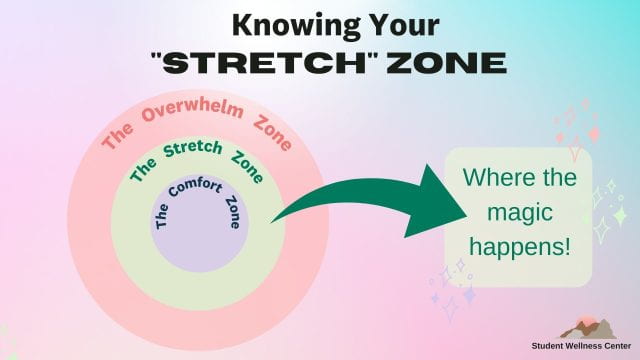As we travel further into the unfamiliar territory of ‘Brave Connections,’ we will introduce a tool that helps us to differentiate between knowing whether the new ideas we encounter are challenging and exciting to us or draining and worrisome. This week, we are zooming in on our “Stretch Zone,”* a term for the space beyond our “Comfort Zone,” in which learning, growth, and transformation can occur. When we connect courageously with new ideas, new people, and new perspectives, we are actively engaged. We might feel anxious, uneasy, inspired, or exhilarated, all the while remaining in a grounding and present state. But these strong emotions can walk a fine line. They may even tip us into the “Overwhelm Zone,” or into a place of panic and disconnectedness. Follow these tips for engaging in brave connections in a manner that maintains our ability to be engaged and challenged, while also confident and grounded.
1. Know your Comfort Zone. What are the practices or activities that reliably bring you comfort? Maybe it’s focusing on your breath. Maybe it is resting on a couch or a bed. Or perhaps it’s connecting with a trusted friend. Write a list of 1 to 3 practices you can do to self-regulate and bring yourself back to a place of comfort and safety.
2. Attend to the body’s cues. Physical responses in the body, like experiencing our flight or fight response, can help us to notice when we are venturing too far into a state of overwhelm. If possible, pivot to a comfortable activity or practice. You might also bring an attitude of non-judgment and curiosity to the strong emotions you are experiencing (try the “Name It To Tame It” technique for how to practice this). Paying attention to our bodies’ cues can also help us recognize when we are grounded and in control, and are able to move into our stretch zones. Try a body scan to connect to these subtle cues.
3. Venture, bravely, into the Stretch Zone. Seeking out new ideas, new people, and new perspectives can enrich our understanding of the world and foster personal growth. There are many ways to enter the stretch zone. Here are just a few suggestions:
- Dig deeper into a controversial topic or stance.
- Read widely, exposing yourself to different genres and viewpoints.
- Attend an Interfaith Dinner or an Interfaith Passport event to engage, courageously and respectfully, with those who hold a different lived experience than ourselves.
- Take a class that is outside your major or on a topic that you are less familiar with.
- Attend a Hood Museum art exhibit, a theater performance at The HOP or check out one of Dartmouth’s many cultural festivals for exposure to diverse narratives.
The Dartmouth community is full of opportunities for each of us to slide into our stretch zones. In fact, our campus is teeming with possibilities for encountering diverse people, cultures, and perspectives! By knowing our comfort zone, recognizing when we are in an appropriate place to stretch and learn, and courageously stepping into the unfamiliar, we are setting ourselves up for continued growth and personal enrichment.
Reflection Question:
What are some ways I have stepped outside my comfort zone this term? What do I notice about my emotions or my physical state of being when I am being “stretched”?
*Inspired by terminology developed by the Mindfulness Institute for Emerging Adults



